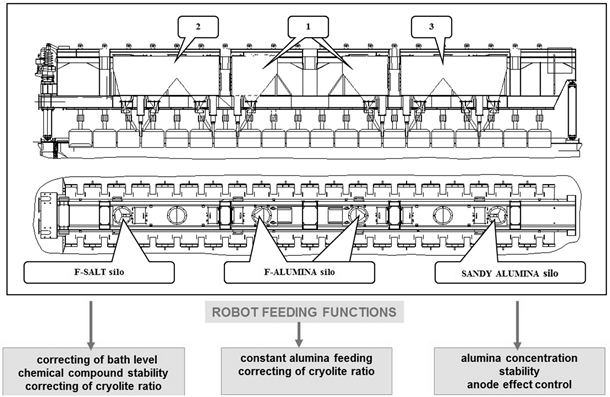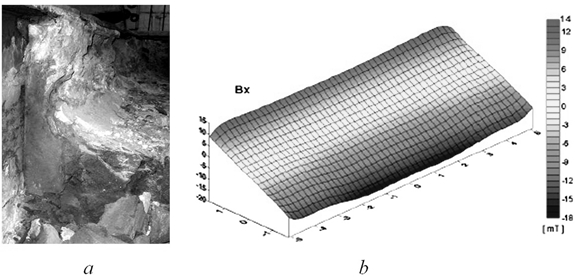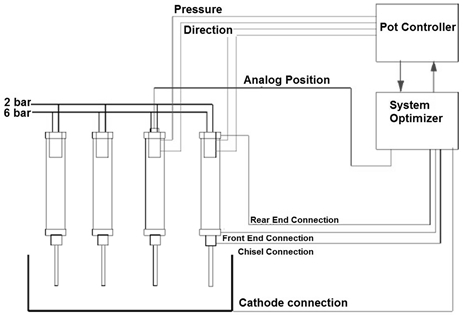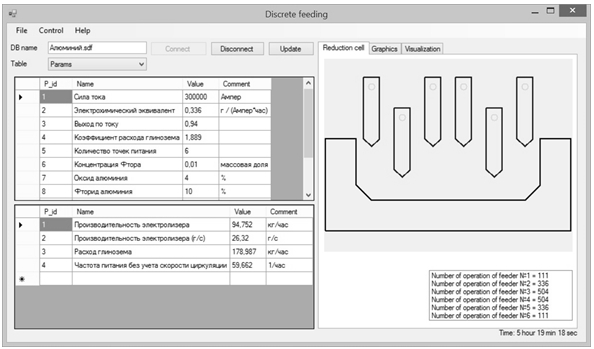РЕЗЕРВЫ РОСТА ЭНЕРГОЭФФЕКТИВНОСТИ ВЫСОКОАМПЕРНОГО ЭЛЕКТРОЛИЗА В ПРОИЗВОДСТВЕ АЛЮМИНИЯ
Петров П.А.1, Шариков Ю.В. 2, Бажин В.Ю.3
1Кандидат технических наук; 2доктор технических наук, профессор; 3доктор технических наук, профессор, Национальный минерально-сырьевой университет «Горный» (Горный университет)
РЕЗЕРВЫ РОСТА ЭНЕРГОЭФФЕКТИВНОСТИ ВЫСОКОАМПЕРНОГО ЭЛЕКТРОЛИЗА В ПРОИЗВОДСТВЕ АЛЮМИНИЯ
Аннотация
Современные технологии электролитического получения алюминия являются результатом долгого развития и совершенствования процесса Эру-Холла, заключающегося в электролизе глинозема, растворенного в расплавленном криолите. В настоящее время это единственный промышленный способ получения первичного алюминия в мире. Ряд альтернативных процессов имеют потенциальные преимущества перед технологией Эру-Холла относительно затрат энергии, себестоимости и экологии, однако они не находят промышленного применения из-за сложности их практической реализации. В статье рассматриваются вопросы повышения энергоэффективности высокоамперных электролизеров для получения алюминия.
Ключевые слова: алюминий, анодный эффект, глинозем, электролиз.
Petrov P.A.1, Sharikov Yu.V.2, Bazhin V.Yu.3
1PhD in Engineering Science; 2Doctor of Engineering Science, professor; 3Doctor of Engineering Science, professor, National Mineral Resources University (Mining University)
THE GROWTH RESERVES OF ENERGY EFFICIENCY OF THE HIGH-AMPERAGE ELECTROLYSIS IN ALUMINIUM PRODUCTION
Abstract
The modern technologies of electrolytic aluminum production are the result of a long development and improvement of the Hall-Heroult process, which consists in the electrolysis of alumina dissolved in the molten cryolite. A number of alternative processes have potential advantages over the Hall-Heroult technology on the expenditure of energy, prime cost and the environment, but they are not in industrial use because of the complexity of their implementation. In this paper improving of energy efficiency for higher amperage aluminum cells are discussed.
Keywords: aluminium, anode effect, alumina, electrolysis.
At present progressive aluminum smelters such as Chalco (China), Alcoa (USA), Rio Tinto Alcan (Canada-France-Australia), and Russian aluminium smelters that are part of RUSAL, for new construction and modernization of plants use cells with prebaked anodes with capacity of more than 300 kA. They reach the following technical and economic parameters: specific energy consumption (12.1 ÷ 13.4 kW/t Al); current efficiency (93.5 ÷ 97.2%); alumina consumption (1912 ÷ 1925 kg/t Al); carbon consumption (0.51 ÷ 0.58 kg C/kg Al); fluoride emissions (0.3 ÷ 0.6 kg F/kg Al); frequency of anode effects (0.01 ÷ 0.3 pcs/day). The consumption of the electric power makes 40% from cost of production of primary aluminum.
It is evidently that aluminum production is one of the most energy-intensive processes, so aluminum plants situated near the major sources of energy or use energy from gas power stations.
The permanently increasing demand for metal production and the development of resource and energy saving technologies in the production of aluminum requires a significant increase of productivity (current efficiency) at the maintaining the possible lower level of energy consumption.
Decreasing of anode effects
The main reason of current efficiency reducing is the metal losses owing to its dissolving in electrolyte and oxidation of anode gases, oxygen, carbon and electrolyte components. Considerable periodically fluctuations of alumina concentration in the electrolyte affect cell energy conditions more than instability of current and air temperature. Changes of alumina concentration have to be in acceptable range 2.0-3.5%. At the concentration of less than 1.5%, the anode effect occurs with a sharp jump of the voltage on the bath. CF4 and C2F6 emitted during anode effect contribute significantly to a global warming. Minimizing the number of anode effects reduces the electricity consumption by 400-600 kW∙h/t Al.
The environmental requirements force companies to reconsider their attitude to the anode effect, and position it as an accident, leading to an increase in emissions and energy consumption. We cannot solve these tasks without a review of cells feeding.
It is known, that during anode effect, voltage sharply raises to 40V at the expense of resistance in anode-cathode distance (ACD) and the thermal balance of reduction pot because of increase of temperature to 980-1000 оС is broken. When the voltage more 20V the consumption of fluorides (AlF3, MgF2) increases, and besides CO2, sharp allocation of gases CO and per fluorocarbon (PFC) emissions CF4, C2F6 with heat begins. Reduction of emissions PFC is one of priority problems for aluminum production for lowing the effect on climate change and environment. Last data shows [1] that in the aluminum industry there is a further progress in reduction of emissions PFC at the expense of global decrease in quantity of anode effects.
In world aluminium production as the capital equipment priority is higher amperage reduction pot with prebaked anodes. For these cells that work with amperage 300 kA was possible to leave stable technological parameters by decreasing quantity of anode effects. Some aluminum smelters have passed to technology for reduction pot with prebake anodes without anode effects (0.03 pieces per day) [2].
For realization of such technology, performance of some actions and the technical decisions connected with automated alumina feeding systems (AFS) is necessary. High competition from developers of installations AFS, difficulties of complex test of technology AFS, its certification and practical marketing don't allow to convince aluminum smelters of expediency of introduction of complex technology connected with management through AFS of cells, despite possibility of decrease in emissions in atmosphere and receptions of additional profit.
A method of controlling an aluminum reduction cell in the laboratories of Mining University (Saint Petersburg) was developed. The main goal consists in maintaining alumina concentration within limits from 1.5 to 3.0% by alternating base in the electrolyte cryolite ratio (CR) 2.2-2.5. By control of special robot devise of alumina feeding system we can regulate of underfeed and overfeed modes and check up with measuring cell voltage and potline amperage. After there are calculating current normalized voltage value and a rate of changing thereof in time, comparing the calculated values of the normalized voltage with preset values thereof and correcting anode-cathode distance when passing from the base mode to the overfeed or underfeed modes with control quantity of alumina which get to cryolite crust (figure1).

Fig.1 - Alumina feeding system (AFS) for decreasing of anode effects
Complexity of labor researches of melt dynamics for reduction pots and physical models conduct to developing more modern economic method of researches – control of the of alumina containing in ACD at continuous monitoring of electric parameters. The essence of the patented method [3] consists in parallel identification of alumina containing in volume of bath with the fixed level of noise in automated systems of management of technological process (ASMTP).
Control of process of dissolution most effectively to spend on a deviation of the resulted voltage on the anodes which are in area of point feeders AFS where a magnet field and melt dynamics it is minimum. This fact allows the better identify of the noise which connected with change of alumina concentration field.
The analysis of tests of electrolyte in various points has revealed that in higher amperage cells constantly there are dynamic changes of bath structure connected with arrival and the expense arriving in the melt substances and to the greatest changes is subject bath ratio.
In settlement fluorine, balance for higher amperage reduction cell is supposed decrease in the expense of aluminum fluoride to 18-20 kg/t Al, basically, at the expense of stabilization CR.
For today because of high aggression of environment of cryolite melt in which occurs for aluminum reduction process, the problem of continuous automatic measurement is solved only for two parameters of technological process: cell voltage and potroom amperage. Portable devices measure other parameters.
Existing alumina feeding algorithms are based on the diagnostic condition of electrolysis cell on a set of the statistical data of gauging. The designed possible technological situation and dosing are carried out only on all feeders in regular intervals at the rate of full of dissolution of alumina portion.
Calculations show that 0.3-0.4 kWh/kg Al (2-3%) of cell energy consumed by parallel materials heat up and reactions inside the cell. Several processes worthy of investigation lose energy: excess of alumina consumption, removed anode assembly enthalpy, radiation from open cavity exposition, cavity cleaning material losses, alumina impurities heat up, aluminium fluoride heat up and reactions [4].
Therefore, the main technical and technological problem is maintenance of full-automated management of aluminum reduction cells based on accurate authentic values of technological parameters.
Indemnification of high amperage and reduction of magnet dynamic influencing
In conditions of higher amperage reduction technology at the expense of stronger magnetic hydrodynamics (MHD) influences on a metal layer, speed of this layers when value of a horizontal magnetic component - Bx and melt turbulence are increase. Metal at movement with a speed υ = 10-17 cm/s carries away bath layers which lag behind on speed on 2-4 cm/s. In a direction vertical magnetic – Bz there are things in common and interface destructions on the boundary "metal-bath". Stabilization of temperature and cryolite ratio at regulation of Al2O3 helps to lower bath stream influence on size of ACD.
Complex measurements of current distribution in the cathode, cell voltage and bath temperature of higher amperage cells have shown that increasing dispersions of average value of a current in cathode bars about 2-3 % led to decreasing of current efficiency about 0.20-0.25 %. For higher amperage cell at increase of a current above design values are noted high levels for Bx which are caused by the forces directed along a surface of aluminium and it is essential deform it therefore increase amperage should be compensate of technical and technological actions.
Owing to excess Ix more than in 3 times increase values of speeds of melt streams which are directed to the target party of the cell that leads to the accelerated deterioration of sidewall lining and to distortion of the cryolite crust (Fig. 2).

Fig. 2 - Destruction sidewall lining on the target party (а) and change longitudinal Bx - magnetic field components (b) at increasing of amperage 15 kА
This conclusion will be coordinated with current measurements and results of dry cleaning of the stopping cathode of cell at major repair where deterioration carbon silicon blocks of potlining on the party B (fig. 1.a is found out 90 %.) in comparison with minimum deterioration from outside A where anode risers settle down. MHD instability also proves to be true given data at studying of alumina concentration field and different carbon containing in the bath on the entrance and target parties of the cell.
Indemnification of influence Bz of the next number of cells is provided special potential with crosspieces which transfer a part of a current from cathode cores near to the middle of an opposite side from the next number cells to other party by busbar which is under the bottom the cathode shell. Settlement MHD indicators give preconditions for steady pot operation at amperage 320 кА and more. As a result it is even at high values of Вх and Ву the cell has high MHD stability and satisfactory of technical and economical performances.
Change of a design of the cathode device with installation of drained wettable bottoms also allows increasing MHD stability of aluminum cell [5].
New scheme and busbar design improvement provide of MHD stability more than on 0.22В. Performance of the specified requirements will allow provide comprehensible indicators on creation multicircuit circulation schemes of the melt in the cell with a speed of 10-12 cm/s and warp of 2-3 cm and a stock of MHD stability. In this connection technical decisions for new project of aluminium smelters are provided of specific electric power consumption 12000-12500 kWh/t .
Stabilization of technological parameters by special robot system
The main problem of controllability of aluminium electrolysis aluminum is that not all basic technological parameters are supervised constantly. Such indicators as an alumina concentration, temperature, cryolite ratio, metal and bath levels are registered periodically (1 time in 1-3 per days) by means of manual measurements. It is offered to operate of aluminium reduction process on accurate boundary conditions by means of systems AFS that are a management basic element for cell and integrate through automated control system ASMTP of values of key parameters by analysis of return signals from gages of controllers (fig. 3).

Fig. 3 – The management scheme technological process by means of integrated feeders AFS
After transformation of the received data from automated control system ASMTP the signal for different feeding (feeding points) by alumina and fluorides on special algorithm taking into account limit values (Table 1).
Table 1 – Limit values of basic parameters
| Parameter | Level conditions | Technical solutions |
| Temperature | 950-955 оС | Term controller |
| Cryolite ratio | 2.25-2.35 | Electro conductivity control |
| Bath level | 18-22 cm | Amperage impulse |
| Metal level | 17-20 cm | Control of touching of cathode bottom |
Higher amperage cells have highly unstable dynamics of the melt along the length and width of the bath (14 ÷ 24 cm/s), which leads to the existence of zones with different rates of dissolution of alumina. Technology development of separated feeding, based on the location of the zones of intensity of alumina dissolution, is an actual way to increase the energy efficiency of aluminium reduction process.
Theoretical and experimental researches of the influence of reduction process parameters on the rate of dissolution of alumina in the electrolyte was carried out in the course of the research work under the Federal program «Scientific and scientific-pedagogical personnel of innovative Russia». They lead the basis of algorithms of the computer program «The discrete feeding an aluminum cell by fluorinated alumina» (figure 4). The algorithm of the independent operation of point feeders of automated alumina feeding system based on information on concentrations of aluminum oxide and cryolite ratio [6]. The space of the cell divided into equal areas, the number of which corresponds to the number of points of feeding.

Fig.4 – Program (№2012614704) «Discrete alumina feeding of aluminum cell»
The algorithm allows determining the rate of dissolution of alumina in the feeding channel, taking into account the physicochemical properties of fluorinated alumina. The adjustment of feeding cycles is carried out at the properties of the melt in the channel are changed.
«Program of monitoring of limit parameters» as a program for process monitoring is used [7]. The program provides the following functions: comparison of the parameters measured by alumina feeding system with their valid boundary values; determination of the required size of the dose and frequency of alumina feeding, depending on the values of the cell parameters and properties of the alumina. These programs using the programming language C# and TSQL are developed. They were included in the package of computer software for solving the problems of intensification the process of electrolytic aluminum production.
To improve the energy efficiency of technology of the higher amperage reduction process it is recommended:
1) to make a periodic adjustment of the chemical composition of the electrolyte, subject to changing of overheat of the electrolyte, depending on the speed of its movement;
2) to stabilize the level of electrolyte in the area of feed zone for more than 19 cm to ensure complete dissolution of the alumina before obtaining the boundaries of the «metal-electrolyte»;
3) to control the apparent density and the fluorine content in alumina from the output of the alumina feeding system in order to optimize cycles of dosing of the discrete feeding system;
4) to monitor the process to stabilize the parameters of electrolysis and efficiency of dissolution of alumina.
A new approach to the algorithmization process of alumina feeding, provides the supply of the individual signals on each point feeder of the cell, with the ability of the correction of feeding cycles depending on the intensity of dissolution of alumina and taking into account the boundary values of process parameters, will allow:
– to lower the number of process variations,
– to realize the feeding without anode effects (less than 0.03 pcs/day) and without the formation of precipitation on the bottoms of the bath with a maximum close to the theoretical loading of alumina,
– to reduce the losses of alumina, and therefore to increase the energy efficiency of higher amperage cells.
Conclusions
Although the Hall-Heroult electrolysis process was discovered more than one century ago, the behavior and optimization of the electrolysis cells are still challenging researchers around the world due to its complexity. Such behavior is the resultant of a wide range of self-interacting parameters. Some parameters are defined by the cell design (cell thermal insulation, production capacity, MHD situation), while other parameters are controlled by a computerized system (cell voltage drop, alumina feeding) and there are also parameters dependent on human interaction (anode changing, anode covering, bath corrections, aluminium tapping).
Because of the large scale production, fine tuning of such complex net of parameters can provide significant energy and cost savings and, as well, important reduction in harmful emission levels.
High technical and economical parameters for higher amperage reduction cell are provided with application of technical and technological actions: use of limit acid electrolyte (CR = 2.25-2.35); metal and bath optimum heights; settlement value of anode cathode distance; alumina concentration in the bath (1.5-3.5 %); use of sandy alumina type; application of integrated alumina systems AFS; increase of MHD stability.
Such technical decisions are provided increasing of electric power consumption 400-600 kWh/per t for primary aluminium for new project of aluminium smelters.
References
- J. Marks. Global Anode Effect Performance: 2010 PFC Emissions Reduction Objective Met // Light Metals. - 2009. - Р. 251-257.
- Kumar, A. Zaroni, and M. Jallaf. Initiatives to Reduce Anode Effect Frequency at Dubal // Light Metals. – 2009. - Р. 259.
- Патент РФ №2011116273. Способ контроля технологических параметров электролита алюминиевого электролизера / Бажин В.Ю., Сизяков В.М., Лупенков А.В., Власов А.А., Фещенко Р.Ю. Опубл. 28.02.2012.
- Патент РФ №2010134138. Катодное устройство электролизера для получения алюминия / Бажин В.Ю., Сизяков В.М. Власов А.А. Патрин Р.К. Опубл. 27.12.2011. Бюлл. №12.
- V. Gusberti, D. S. Severo, B. J. Welch, M. Skyllas-Kazacos. Modelling the Aluminium Smelting Cell Mass and Energy Balance – a Tool Based on the 1st Law of Thermodynamics, 10th Australasian Aluminium Smelting Technology Conference, Launceston, Australia, 2011. - P. 934-940.
- Свидетельство об официальной регистрации программы для ЭВМ №2012614704. Дискретное питание алюминиевого электролизера фторированным глиноземом / Петров П.А., Власов А.А., Выходцев Я.Н., В.Ю. Бажин. Опубл. 25.05.2012. Бюл. изобр.
- Свидетельство об официальной регистрации программы для ЭВМ №2011615779. Программа управления алюминиевым электролизером по граничным значениям технологических параметров / Петров П.А., Белоглазов И.Н., Бажин В.Ю., Лупенков А.В., Власов А.А. Опубл. 22.07.2011. Бюл. изобр.
